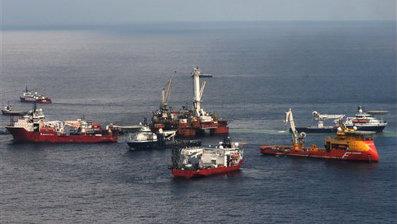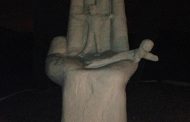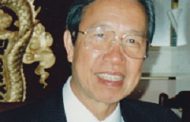 In this May 26 photo provided by the U.S. Coast Guard, a mobile offshore drilling unit holds position over the damaged Deepwater Horizon blowout preventer as crews work to plug the wellhead. (AP Photo)
In this May 26 photo provided by the U.S. Coast Guard, a mobile offshore drilling unit holds position over the damaged Deepwater Horizon blowout preventer as crews work to plug the wellhead. (AP Photo)
April 20
In the Gulf: An offshore oil drilling rig owned by Transocean and operated by BP explodes in the Gulf of Mexico nearly 50 miles of the Louisiana coast.
At the White House: The president returns to Washington from Los Angeles, where he was attending a set of Democratic fundraisers the night before.
April 21
In the Gulf: Coast Guard helicopters search for 11 missing oil rig workers.
At the White House: Obama meets with Senate Judiciary Committee members at the White House to discuss the Supreme Court vacancy. He later hosts a reception for G20 labor officials.
April 22
In the Gulf: The Deepwater Horizon rig sinks, while search-and-rescue efforts continue.
At the White House: Representatives from 16 federal agencies collaborate as part of a national response team to the Gulf disaster. Obama travels to New York City to discuss his financial regulatory bill. The president later holds a meeting in the Oval Office about the response to the oil rig tragedy. The White House releases a statement saying Obama is ensuring the government is offering “all assistance needed” in the rescue effort and in responding to the environmental impact.
April 23
In the Gulf: The Coast Guard ends the search for the missing 11 workers, who are presumed dead, at the end of the day. The Coast Guard reports that oil does not appear to be leaking from the well head, though they are trying to contain what spilled in the explosion.
At the White House: Obama and the first family travel to Asheville, N.C., for vacation.
April 24
In the Gulf: The Coast Guard discovers oil leaking from the ocean floor.
At the White House: Obama plays golf in North Carolina.
April 25
In the Gulf: The Coast Guard estimates up to 1,000 barrels are leaking in the Gulf every day in the wake of the blast. Dozens of boats and hundreds of response workers are deployed to contain the spill.
At the White House: Obama leaves Asheville to attend a memorial service for the West Virginia miners who died in the Upper Big Branch explosion.
April 26
In the Gulf: About 15,000 gallons of dispersants and 21,000 feet of boom are used at the spill site to mitigate the damage from the leak.
At the White House: Obama greets the New York Yankees at the White House, then speaks at an entrepreneurship summit.
April 27
In the Gulf: More boats are deployed to the Gulf. Coast Guard officials say they’re considering lighting the spill on fire.
At the White House: The Obama administration launches an investigation into the explosion. Administration officials meet with BP executives. Obama meets with the newly formed debt and deficit commission, then travels to Iowa to speak at an energy facility.
April 28
In the Gulf: Crews start to set fire to select sections of the spill. The Coast Guard reports that it has found a new leak, and updates its estimate of the spill from 1,000 to 5,000 barrels a day.
At the White House: Obama talks about the economy in Missouri. He later travels to Illinois to talk about financial reform. He is briefed on Air Force One about the spill on the way back to Washington.
April 29
In the Gulf: The Coast Guard says the oil spill could soon reach landfall, while mitigation efforts continue.
At the White House: Obama, in his first public remarks on the spill, pledges to deploy “every single available resource” in response. He speaks with the governors from five Gulf states, while Homeland Security Secretary Janet Napolitano declares a “spill of national significance.”
April 30
In the Gulf: Oil reportedly begins to wash ashore in Louisiana’s wetlands. High winds make coastal protection efforts difficult.
At the White House: Obama again addresses the spill in public remarks. He suspends new offshore oil drilling but reaffirms his commitment to domestic oil production. The president order an immediate review on rig safety and sends top administration officials to the Gulf coast.
May 1
In the Gulf: Two more offshore platforms are shut down in the Gulf of Mexico as a precaution. Crews continue using dispersants by the leak. The slick from the explosion has tripled in size. Coast Guard Commandant Adm. Thad Allen is put in charge.
At the White House: Obama speaks at the University of Michigan commencement. Obama later attends the White House Correspondents Dinner.
May 2
In the Gulf: More vessels and response teams are deployed. Fishing is shut down from the Mississippi River to the Florida panhandle.
At the White House: Obama travels to the Gulf coast to survey the damage and meet with local officials. He calls the spill a “potentially unprecedented” disaster and pledges a “relentless” federal response. Obama is later briefed on the attempted Times Square bombing.
May 3
In the Gulf: BP’s executive says crews are reducing the amount of oil reaching the surface by using dispersants. He pledges that BP will pay “all necessary and appropriate” costs associated with the clean-up.
At the White House: The administration, holding a meeting with BP executives, presses BP to explain how it will cover those clean-up costs. The president has a conference call with Allen and local officials to discuss the response.
May 4
In the Gulf: Winds in the Gulf of Mexico calm down, giving crews a chance to lay down boom by the shorelines. BP tries to cap a small leak while preparing to place a containment dome over the main leak.
At the White House: Obama speaks at the Business Council in Washington. There he pledges to minimize economic damage from the oil spill.
May 5
In the Gulf: BP caps one of the three oil leaks, though thousands of barrels of oil continue to leak into the Gulf.
At the White House: Obama attends a Cinco de Mayo celebration at the White House.
May 6
In the Gulf: Officials confirm that oil has made landfall on the Louisiana coastline. BP prepares to lower a giant box over the oil well to capture the leak.
At the White House: Obama participates in a national security meeting on Afghanistan and Afghanistan.
May 7
In the Gulf: Robots place a 100-ton box over the oil well on the ocean floor, in an unprecedented attempt to stop the flow. Officials expand the coastal area closed to fishing due to the spill.
At the White House: No public events.
May 8
In the Gulf: Balls of tar begin washing up on Alabama’s beaches. Meanwhile, the 100-ton box meant to capture the leak is not working.
At the White House: Obama delivers his weekly radio address on holding insurance companies more accountable.
May 9
In the Gulf: BP officials say, after the 100-ton box fails to stop the leak, that they may try to do the same thing with a smaller box. Approximately 3.5 million gallons of oil have spilled into the Gulf at this point.
At the White House: Obama speaks to graduates at Hampton University in Virginia.
May 10
In the Gulf: BP announces it will try to place a smaller dome over the leaking oil well in the Gulf of Mexico.
At the White House: Obama meets with Cabinet officials and senior staff at the White House to discuss the oil spill response.
May 11
In the Gulf: Response crews replenish fuel and water in preparation for long-term relief efforts.
At the White House: Reports surface that the Obama administration has proposed splitting up the Minerals Management Service, the agency responsible for overseeing offshore drilling. One arm would be tasked with inspecting rigs and enforcing regulations while the other would oversee drilling leases.
May 12
In the Gulf: Crews lower the new, smaller containment box to the Gulf of Mexico floor.
At the White House: Obama meets with Afghan President Hamid Karzai at the White House, then takes questions from the press.
May 13
In the Gulf: BP prepares to suck oil away from the spewing well before trying to place the smaller containment box on top.
At the White House: Obama flies to Buffalo, N.Y., for a tour and town hall meetings at a local factory. He later travels to New York City for a Democratic Congressional Campaign Committee event.
May 14
In the Gulf: BP uses robots to try to insert a small tube into the leaking pipe on the Gulf floor, in an attempt to seal it off and siphon oil to the surface.
At the White House: Obama honors TOP COPS award recipients at the White House.
May 15
In the Gulf: BP struggles to install the tube into the oil pipe, but expresses optimism in the plan. The company continues to drill a relief well, which is considered the permanent, though time-consuming, solution to the problem. The process is about halfway done.
At the White House: Obama speaks at the National Peace Officers Memorial Service. He delivers his weekly radio address on “Wall Street Reform.”
May 16
In the Gulf: BP crews successfully hook the tube to the oil pipe to siphon oil to a tanker ship. Researchers say the oil has entered a current that could carry it toward the Keys.
At the White House: No publicn events.
May 17
In the Gulf: BP claims the tube is sucking out more than 42,000 gallons a day from the Gulf floor to a tanker ship. That’s still a fraction of the oil leaking out from the well.
At the White House: Obama hosts the NCAA tournament champion University of Connecticut women’s basketball team.
May 18
In the Gulf: A U.S. official says it is “increasingly likely” the oil will be swept out to the Florida coastline.
At the White House: Obama visits a factory in Youngstown, Ohio.
May 19
In the Gulf: U.S. officials reportedly hold talks with Cuban officials on response efforts amid concerns that the oil slick is spreading even farther.
At the White House: Obama welcomes Mexican President Felipe Calderon to Washington. Both heads of state publicly criticize Arizona’s new immigration law. The president hosts a state dinner for Calderon at night.
May 20
In the Gulf: BP continues to siphon out oil from the busted well. The company begins preparing for a new plan to stop the oil leak called a “top kill.” The plan involves injecting mud into the top of the well and then sealing the area with cement.
At the White House: No public events.
May 21
In the Gulf: BP continues to prepare for the “top kill” procedure, while officials find animals covered in oil.
At the White House: No public events.
May 22
In the Gulf: BP says it intends to continue using chemical dispersants after the EPA raises concerns about their long-term effects. Oil continues to wash ashore.
At the White House: Obama announces a presidential commission to investigate the disaster. He says in his weekly radio address that the panel, which is given six months to complete its work, is intended to figure out the “root causes” of the explosion and figure out how to make offshore drilling safer. The president speaks at the West Point commencement ceremonies in the morning.
May 23
In the Gulf: BP says it will take at least another two days before crews can start to implement the “top kill” plan to plug the leaking well. BP continues to siphon out some oil from the leak.
At the White House: Obama orders top administration officials back to the Gulf to monitor the response.
May 24
In the Gulf: BP continues to prepare for the “top kill” procedure, as oil moves deeper into the Louisiana marshes.
At the White House: Obama meets with Lebanese Prime Minister Saad Hariri. Interior Secretary Ken Salazar and Homeland Security Secretary Janet Napolitano lead a Senate delegation to the Gulf region.
May 25
In the Gulf: BP agrees to show a live feed of the “top kill” procedure under pressure from the Obama administration.
At the White House: Obama meets Italian President Giorgio Napolitano, then travels to San Francisco for fundraisers for Sen. Barbara Boxer, D-Calif., and the Democratic Senatorial Campaign Committee.
May 26
In the Gulf: BP attempts to use the “top kill” method to shoot mud into the well. Meanwhile, BP says 25,000 claims for economic losses have been submitted, and that it has already paid close to $30 million.
At the White House: Obama visits a solar facility in Fremont, Calif.
May 27
In the Gulf: BP continues to shoot heavy mud into the well, a process that appears to be making progress.
At the White House: Several developments related to the spill emerge in Washington. Minerals Management Service director Elizabeth Birnbaum resigns. The Obama administration announces new restrictions on offshore oil drilling, canceling and delaying certain projects. Obama holds a major press conference in which he declares the federal government is “in charge” and pledges to stop the leak. Obama leaves for a family vacation in Chicago at night.
May 28
In the Gulf: BP continues to try the “top kill” method, but also tries shooting rubber and other man-made “junk” into the well.
At the White House: Obama tours the Louisiana coastline. He says the federal government is treating the spill as its highest priority — he says the government has deployed 1,400 National Guard troops, 1,400 vessels and 3 million feet of boom
May 29
In the Gulf: BP offered few details on its latest bid to plug the well as progress was difficult to measure from BP’s “spillcam” of mud, gas and oil billowing from the seafloor.
At the White House: Obama returns to Chicago for his Memorial Day weekend vacation.
May 30
In the Gulf: BP says it will try another containment effort beginning on Monday or Tuesday.
At the White House: Obama remained in Chicago for the Memorial Day weekend vacation. The White House released a summary of a discussion between Obama and chief liaison Thad Allen, which said the government is tripling its environmental cleanup team in areas affected by the spill. Environmental adviser Carol Browner appeared on NBC’s “Meet the Press.” She said 150 government scientists are on the case.
May 31
In the Gulf: Transocean, which owned the rig that it leased to BP, said it would like its liability limited. The beach at Grand Isle, La., which was hit with oil from the spill, and other areas along the coast were opened but swimming and fishing was prohibited.
At the White House: The White House confirmed that its national incident commander Thad Allen will begin on Tuesday to hold daily press briefings from the scene of the spill. The Justice Department announced Attorney General Eric Holder and U.S. attorneys will meet with state attorneys general and hold a press conference on Tuesday.
FOXNews.com










































